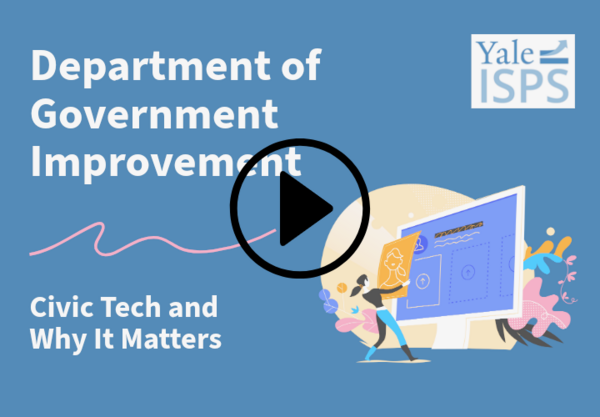The Department of Government Improvement: Civic Tech and Why It Matters
On the day the federal government launched healthcare.gov, only six people successfully signed up for a health insurance plan.
But it got better.
Government workers eventually repaired the website created to help implement the legislation commonly known as Obamacare. And the technological debacle prompted President Barack Obama to invite Silicon Valley talent into government, ultimately creating two key entities: the U.S. Digital Service (USDS) and 18F, the digital services office of the General Services Administration (GSA).
“It caused him to think about how we improve government capacity in a way that presidents don’t normally have those conversations or thoughts,” said Donald Moynihan, the J. Ira and Nicki Harris Family Professor of Public Policy at the University of Michigan’s Ford School of Business and director of the Better Government Lab.
Earlier this month, the Institution for Social and Policy Studies invited Moynihan to discuss the origins, evolution, successes, and challenges of the civic technology movement with ISPS Director Alan Gerber, Sterling Professor of Political Science.
“We were so pleased to host Don for our latest conversation on matters of public importance and interest in representation, elections, democracy, and government performance,” Gerber said. “As researchers and citizens, we must continue to scrutinize how technology intersects with governance, public service delivery, and democratic accountability.”
The webinar was sponsored by Democratic Innovations, an ISPS program focused on identifying and testing new ideas to improve the quality of democratic representation and governance. The program supports conferences, postdoctoral associates, and research on public policy, political behavior, elections, and more.
Moynihan spoke about how the USDS and 18F tackled problems, often saving money and improving services. For example, he said one team, over three days, saved the Department of Defense $500 million in contract costs. The government also used their new expertise to create a free online tax filing system with high user satisfaction and digital renewal systems for passports and Medicaid benefits.
Moynihan said USDS and 18F helped agencies write open-source software and manage vendor relationships, tasks that are often opaque to the public but crucial for effective administration.
“They had a very large impact,” he said. “But also one that was often difficult for the public to see.”
President Donald Trump’s new Department of Government Efficiency (DOGE) largely dismantled USDS and 18F.
Moynihan criticized the government’s long-standing preference for outsourcing technology rather than building internal capacity. He said this approach, rooted in 1990s bipartisan thinking, led to a loss of institutional knowledge and left agencies vulnerable to vendor manipulation.
“Government contractors have this really large information advantage,” he said, arguing instead for a hybrid model. “Government should have enough capacity to build products that it needs quickly.”
Moynihan said technologists with “pro-social motivation” drove the civic tech movement, often seeking more meaningful work after building their careers at companies like Google and Amazon. They brought values such as user-centered design and rapid iteration with them to the government. But some early efforts failed out of naiveté about how government works and a lack of humility and respect for bureaucratic constraints.
“The tech is not the hard part,” he said. “It’s building within the context of government. Often, they are doing what they are doing for a reason that might not have been apparent to you.”
Despite recent setbacks and the unclear fate of government services, Moynihan expressed hope in the possibilities for civic tech to transform lives for the better.
“My best-case scenario now is all of these civic tech people are going to scatter into state governments, and some of them will do remarkable and wonderful things,” he said. “That will be proof of concept.”
And he said there should be space in American governance to agree on basic goals, regardless of which party is in charge.
“Say government has decided we’re going to help veterans, or we’re going to provide support for income, or we’re going to make it easier to start a business — whatever your policy is,” he said. “And then get technologists on board with delivering that policy in the best way. That might involve some building in-house. It might involve some contracting out. Probably some combination of the two. But those by themselves shouldn’t be inherently partisan questions.”
